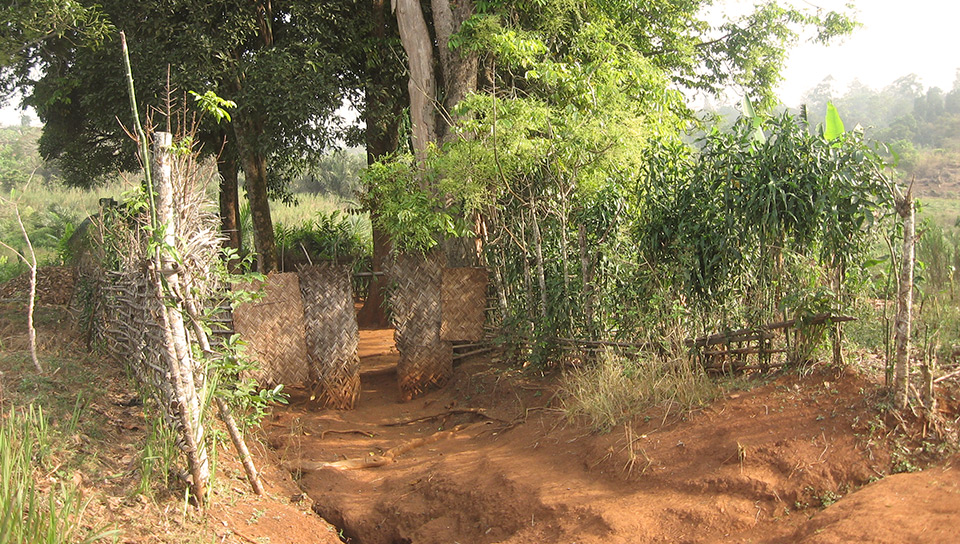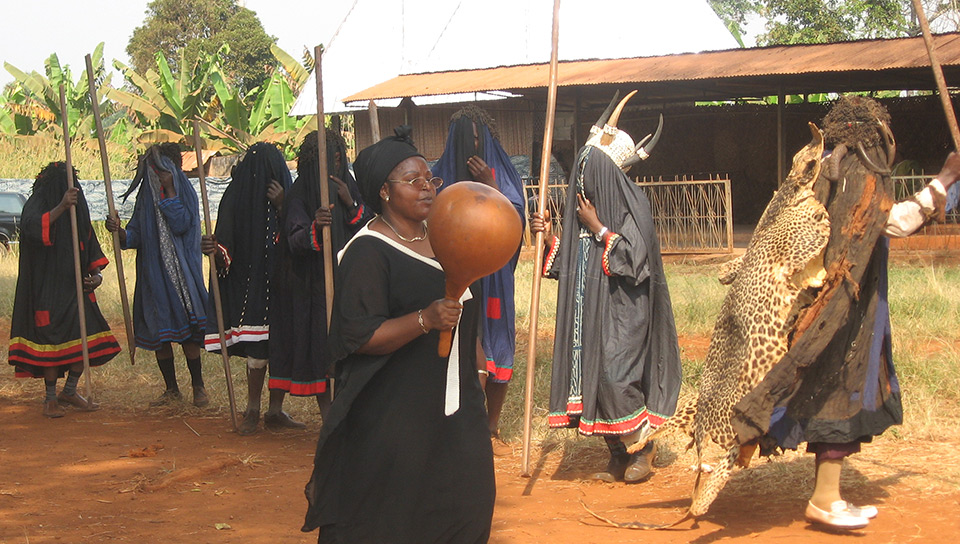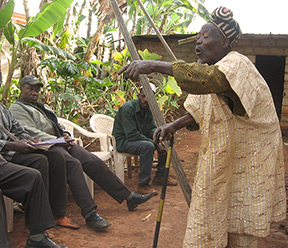در قلمرو Bandjoun در غرب کامرون دروغ سایت های مختلف به عنوان مقدس توسط مردم محلی تلقی. They are the remnant cores of sites that were historically a lot more extensive representing the identity of tribes and communities in the region. The character of separate sites differs in terms of function and the social group that makes use of it. Two examples are family shrines, usually with presence of a fig tree (Ficus sp.), and community gathering places which constitute centres of traditional initiations to the community life. تابع مشترک بسیاری از سایت ها، پرستش خدایان است. حتی اگر محیط زیست از این سایت های مقدس طبیعی توجه کمی تا به امروز دریافت کرده است, آنها به بندر حیوانات و گیاهان است که تا حد زیادی از مناطق اطراف آن ناپدید شده شناخته شده است.
تهدید
Traditional leaders stated that the survival of sacred areas is not threatened because these areas are strongly linked with the community identity. Nevertheless they worry about the changing attitude of young people who are becoming increasingly materialistic and disobey taboos and show lest respect for ancestral beliefs. امروز, بسیاری از مردم از مناطق مقدس بدون اطلاع نگهبان خود را, نشان دهنده فرسایش از هنجارهای فرهنگی. بیشتر تهدید های کلیدی شناسایی شده اند, هنوز مورد بحث در میان مردم محلی خود.
Infrastructure development, especially road construction and urban settlement, has caused the degradation of sacred areas in Bandjoun. The expansion of Christianity offers alternative views on the need for protection and honesty. Some Christian priests are said to have a diabolic view on the sacred sites. According to some local traditional spiritual leaders the fact that for Christian’s punishment of wrong deeds comes after death, while for local beliefs punishment takes immediate effect increases people’s disobedience of the ancestral beliefs and taboos.
اما, a decreasing influence of Christianity on local beliefs is also reported as well as an increasing willingness of Christian priests to listen to locals and work on an interfaith understanding. According to some, even modern education can have a negative impact on traditional beliefs, due to the decreasing time children spend with their parents. علاوه بر این, the changing lifestyles cause a decreased interest in traditional values putting the continued care for these sacred natural sites at risk.
نگاهبانان
در طول قرن ها, مردم Bandjoun را توسعه داده اند یک سیستم مدیریت اجدادی از سایت های مقدس طبیعی. محل از سایت های مقدس طبیعی و نیمه طبیعی است توسط رهبران روحانی آغاز مشخص (MkamSi, Guèkè). در حالی که اکثر طولانی تثبیت شده است, the location of a sacred area is not immutable and can be changed for reasons like road construction or socio-political reorientation. عموما, هر منطقه مقدس می آید تحت مسئولیت متولی به نام Nongtchuép. او مسئول ساخت ارائه و فداکاری است, که او نیز می تواند یک نماینده اجباری. These are initiated elders who are universal custodians. آنها حق کار در تمام سایت های عبادت.
Even though women are generally regarded as heaving little to do with sacred areas, deeper investigation revealed that their role is present, but hidden and ignored. مثلا, Megnesi (female equivalent of MkamSi) have the same capacities and duties as their male counterparts. Only the mothers of initiated twins can clean certain sacred sites. A woman can substitute the family chief and make offerings and sacrifices at a sacred place. بعلاوه, the traditional education is primarily given by women who enforce conservation regulations for sacred areas.
ابزارهای حفاظت
ابزار های زیر را برای حفاظت از تاسیس شده اند تا کنون:
- لیستی از اقدامات بعدی را به
- لیستی از ذینفعان
- اظهارات رهبران سنتی
- مطالعات اجتماعی حاوی دیدگاه مردم محلی در مورد وضعیت
- نقشه های مشارکتی از سایت های مقدس طبیعی در منطقه
دید
بزرگترین پیشرفت حمایت از حفاظت از مناطق مقدس به رسمیت شناختن قانونی خود خواهد بود, افزایش آگاهی عمومی, کاهش تغییرات منفی در استفاده از زمین و شناخت بهتری از اهمیت اجتماعی و فرهنگی و زیست محیطی آنها. برای دستیابی به تمامی موارد بالا دخالت سهامداران در محلی نیاز, سطوح ملی و بین المللی.
ائتلاف
Effective and appropriate support is needed for further conservation of these sites. As a possible solution, Bandjoun community members suggest that involving stakeholders like women, young people, سازمان های غیر دولتی, religious institutions and maybe even state institutions to develop management in sacred areas in a participatory way whilst clearly agreeing on the role of each stakeholder.
اقدام
اقدام کوچک است در حال حاضر انجام شده, جز برای مطالعات کمی بالا بردن آگاهی مردم Bandjoun که سایت های مقدس خود را در معرض خطر هستند. Banjoun نیاز به پشتیبانی برای شناسایی در معرض خطر از سایت های مقدس طبیعی برای جوامع مهم. آنها می خواهم یک مرزبندی روشنی از آنها برای ایجاد و توسعه یک استراتژی مناسب برای مدیریت پایدار خود را.
سیاست و حقوق
سایت های مقدس طبیعی در این منطقه در حال حاضر از نظر قانونی به رسمیت شناخته شده نیست. مدیریت جنگل کلی نگرانی از وزارت جنگلها و حیات وحش با توجه مجسمه کامرون قانونی است.
به عنوان یک نتیجه از یک مطالعه اجتماعی, افزایش آگاهی از مردم Bandjoun دستاورد مهم این است که تا کنون. این مشخصات به طور گسترده ای برگزار شد که دخالت دولت در مدیریت از سایت های مقدس طبیعی می تواند خطرات و در حال حاضر تولید و درگیری است. ماموران دولتی مشکوک می خواهید به منابع مناسب, قصد تضعیف قدرت از بزرگان. اعضای انجمن بالا بردن سطح آگاهی عمومی, نقشه برداری و demarcating مرزهای مناطق مقدس, بهبود دانش, stakeholders working together and devolving power of the government could all be good solutions to stop the worsening situation.
- Kamga-Kamdem S L., (2010) Ancestral Beliefs and Conservation. The case of sacred natural sites in Banjoun, west Cameroon, در Verschuuren, B., R. وحشی, McNeeley, J. و اوویدو., G. (گردآورندگان.) سایتهای مقدس طبیعی, حفظ طبیعت و فرهنگ, زمین اسکن, لندن,.ص. 119-128.






